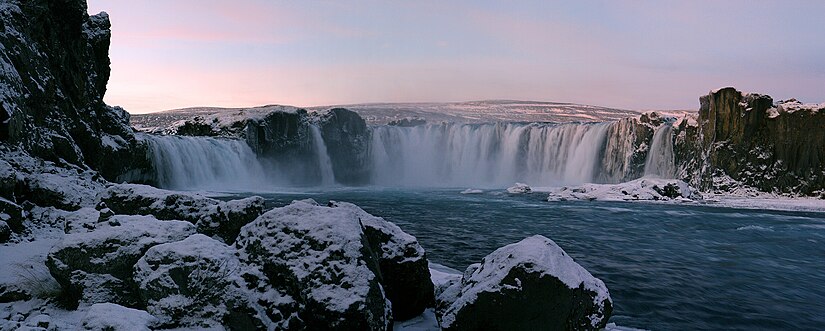The Iceland Portal
Iceland (Icelandic: Ísland, pronounced [ˈistlant] ) is a Nordic island country between the North Atlantic and Arctic Oceans, on the Mid-Atlantic Ridge between North America and Europe. It is culturally and politically linked with Europe and is the region's westernmost and most sparsely populated country. Its capital and largest city is Reykjavík, which is home to about 36% of the country's roughly 380,000 residents (excluding nearby towns/suburbs which are separate municipalities). The official language of the country is Icelandic. Iceland is on a rift between tectonic plates, and its geologic activity includes geysers and frequent volcanic eruptions. The interior consists of a volcanic plateau with sand and lava fields, mountains and glaciers, and many glacial rivers flow to the sea through the lowlands. Iceland is warmed by the Gulf Stream and has a temperate climate, despite a latitude just south of the Arctic Circle. Its latitude and marine influence keep summers chilly, and most of its islands have a polar climate. According to the ancient manuscript Landnámabók, the settlement of Iceland began in 874 AD, when the Norwegian chieftain Ingólfr Arnarson became the island's first permanent settler. In the following centuries, Norwegians, and to a lesser extent other Scandinavians, immigrated to Iceland, bringing with them thralls (i.e., slaves or serfs) of Gaelic origin. The island was governed as an independent commonwealth under the native parliament, the Althing, one of the world's oldest functioning legislative assemblies. After a period of civil strife, Iceland acceded to Norwegian rule in the 13th century. In 1397, Iceland followed Norway's integration into the Kalmar Union along with the kingdoms of Denmark and Sweden, coming under de facto Danish rule upon its dissolution in 1523. The Danish kingdom introduced Lutheranism by force in 1550, and the Treaty of Kiel formally ceded Iceland to Denmark in 1814. (Full article...) Selected article -The Icelandic Phallological Museum (Icelandic: Hið íslenzka reðasafn [ˈhɪːð ˈistlɛnska ˈrɛːðaˌsapn̥]), located in Reykjavík, Iceland, houses the world's largest display of penises and penile parts. As of early 2020 the museum moved to a new location in Hafnartorg, three times the size of the previous one, and the collection holds well over 300 penises from more than 100 species of mammal. The museum also holds 22 penises from creatures and peoples of Icelandic folklore. In July 2011, the museum obtained its first human penis, one of many promised by would-be donors. Its detachment from the donor's body did not go according to plan and it was reduced to a greyish-brown shriveled mass that was pickled in a jar of formalin. The museum continues to search for "a younger and a bigger and better one." (Full article...) Selected picture Strokkur (meaning churn) is a geyser in the geothermic region beside the Hvítá River. The geyser is only a few meters away from Geysir. News
Main topicsSelected biography - Bolli Bollason (also Bolli Bollison) was a key historical character in the Medieval Icelandic Laxdæla saga, born around 1000. He grew up in Orlygsstadir, at Helgafell on the Snæfellsnes Peninsula in Iceland. He divided his time between Helgafell and Tunga, the home of Snorri the Goði. He was held in the highest regard among the contemporary Scandinavian rulers, and also in the Eastern Roman Empire. It is believed that he had reached the rank of manglabites in the Eastern Roman army, and on his return to Iceland, his finery and recognition earned him the name "Bolli the Elegant". His importance in the literary context of the saga is his prominence as the son of Bolli Þorleiksson and Guðrún Ósvífursdóttir, the two central characters of the work. He is mentioned at the end of the Sneglu-Hall þáttur (The Tale of Sarcastic Halli), and is also the subject of his own tale, the Bollaþáttur, which was later appended to the end of the manuscripts in the early 14th century. (Full article...) Did you know (auto-generated) -

Selected quoteGeneral imagesThe following are images from various Iceland-related articles on Wikipedia.
Selected panorama The Goðafoss is a waterfall in which the water of the river Skjálfandafljót falls from a height of 12 meters over a width of 30 meters.
CategoriesThings you can do
Wikipedia in Icelandic
Recognized content
New articlesThis list was generated from these rules. Questions and feedback are always welcome! The search is being run daily with the most recent ~14 days of results. Note: Some articles may not be relevant to this project.
Rules | Match log | Results page (for watching) | Last updated: 2024-11-03 20:35 (UTC) Note: The list display can now be customized by each user. See List display personalization for details.
Web resources
Associated WikimediaThe following Wikimedia Foundation sister projects provide more on this subject:
SourcesDiscover Wikipedia using portals | |||||||||||





















































